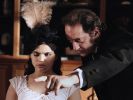Eye For Film >> Movies >> Augustine (2012) Film Review
Things come in threes, not only in classic fairy tales but also in Alice Winocour's enticing and spirited first feature Augustine. Her film tells the story of a kitchenmaid, who was among neurologist Jean-Martin Charcot's (Vincent Lindon) most famous cases of hysteria in late 19th century Paris.
During my conversation with Lindon at last year's Rendez-Vous with French Cinema, we spoke about film and truth. He told me that for him, a film only works if what happens is believable. Winocour adds an extra level of emotional authenticity to her story of Augustine, by including accounts of actual female patients of the 21st century, dressed and coiffed in 19th century styles. The women tell of their woes, of cutting and anorexia without using these words, all caught in the wide net called hysteria, provoking us to think of centuries of "cures" for unruly women, such as witch-hunting or circus displays.

We start in a downstairs kitchen with a pot of live crabs attempting to escape from boiling water. Augustine (perfectly portrayed by Soko) has to serve the shellfish upstairs, feels shaky, and ultimately collapses in front of her employers and their guests, twitching, kicking and convulsing uncontrollably on the dining room floor. The lady of the house and each one of her guests watch in horror and fascination for what seems a very long duration without lifting a finger to help the young woman.
The sense of time stretched out, coupled with inaction and voyeurism, is used twice more, with a vastly different audience witnessing Augustine's attacks. Her cousin Rosalie, also a maid in the household (Roxane Duran who impressed in Michael Haneke's The White Ribbon and Delphine and Muriel Coulin's 17 Girls) brings her to the Salpêtrière, the Belle Époque's most renowned psychiatric hospital, to be presented to the reigning professor of anatomical pathology, Jean-Martin Charcot, god-like, all-knowing, teacher to Sigmund Freud, William James, and Georges Gilles de la Tourette. A marvellous Lindon plays Charcot as powerful, thoughtful inventor - with certain limitations. His elegant wife Constance (Chiara Mastroianni), who quotes Guy de Maupassant's criticism to him over breakfast, receives a compliment now and then. Charcot never emits the tiniest smile to anybody and allows his female pet monkey to climb all over him, even at his office.
His famous demonstrations had hypnotised women perform their symptoms in front of the all-male audience of colleagues and disciples. How much the sexual nature of the doctors' interest was repressed and how it returned in turbulent displays by the patients, is questioned in this film that observes the difference between protégées and case studies. His humanity varies from patient to patient.
Augustine's illness, the doctor calls it "ovarian hysteria" and "hysterical wink," transforms with her. The symptom of a permanently closed right eye – which the girl decorates with a brown velvet ribbon – turns into a clenched left fist after the beheading of a rooster replaces the terror of the initial live crabs.
Movies have looked at female hysteria before. How could they not, with the invention of photography progressing hand in hand with the medical research? Attractive patients are preferred. Keira Knightley's marvelous Sabina Spielrein in David Cronenberg's A Dangerous Method (2011) is united in spirit with the pretty kitchenmaid.
Augustine belongs to a family of movies that scrutinise the social construct of illness, not with a lecture but with a wayward glance - an enchanted barren vineyard behind the Salpêtrière, linens hung to dry in the winter air. Women are being inspected, drawn upon with red medical pens, compartmentalised.
The score by composer Jocelyn Pook (best known for Kubrick's Eyes Wide Shut) turns the feel of the hospital into a new experience. The fascination with female distress fits many an agenda and Augustine shows how fantasies are performative.
In Germany, Pale Mother (1980) Helma Sanders-Brahms reveals a woman whose face becomes paralyzed, post Second World War, when the battles moved inside the homes. Agnès Varda's Cleo From 5 To 7 (1962) ends at the Salpêtrière, and the ghosts of patients past cannot be ignored.
In tone, Augustine is located between Hysteria (2011), Tanya Wexler's comedic exploration that uses the plot of the Katharine Hepburn/ Cary Grant classic Holiday and the heartbreaking Black Venus (2010), in which Abdellatif Kechiche follows the life of Sarah Baartman known as "Hottentot Venus".
Beauty is manufactured, like a symptom on display. "You are beautiful tonight," says Charcot to his wife, startled, looking up from his dinner. "It took me all afternoon," Constance responds. The pet monkey, sitting on the table, decides to have a piece of bread. Winocour's movie is extraordinary.
Reviewed on: 24 Feb 2013



















